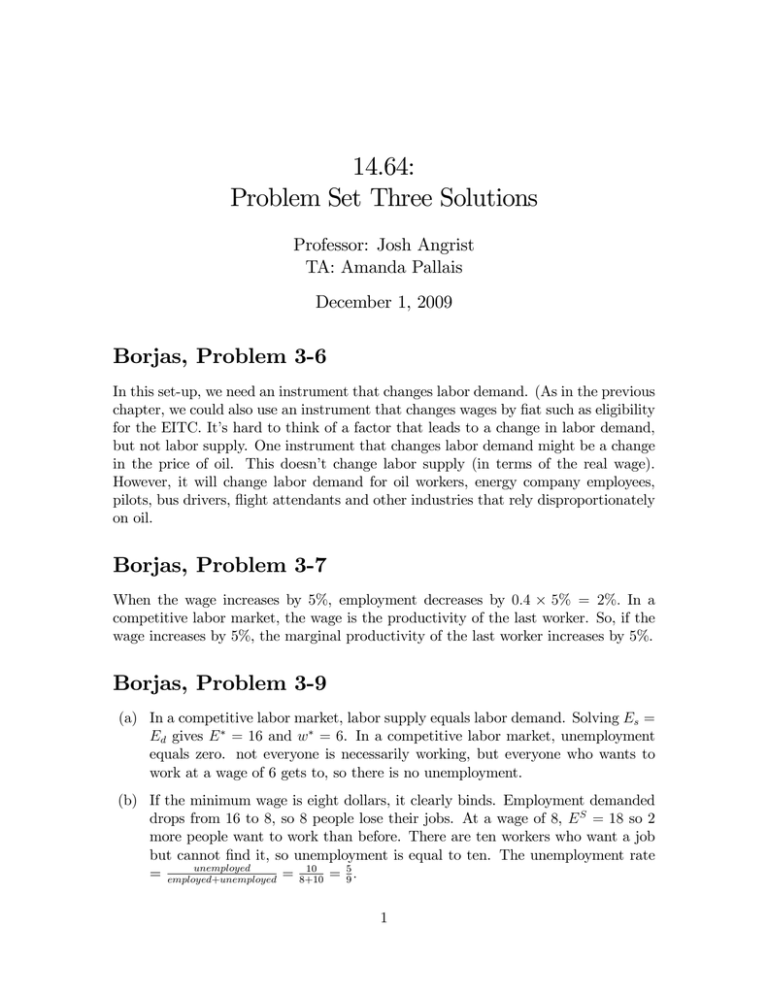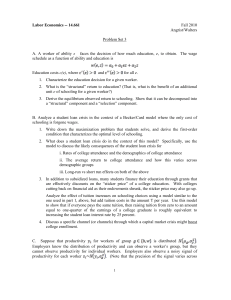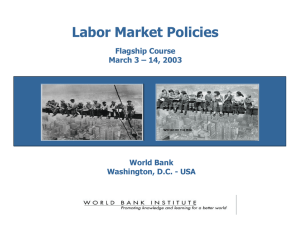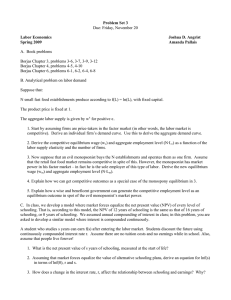14.64: Problem Set Three Solutions Borjas, Problem 3-6 Professor: Josh Angrist
advertisement

14.64: Problem Set Three Solutions Professor: Josh Angrist TA: Amanda Pallais December 1, 2009 Borjas, Problem 3-6 In this set-up, we need an instrument that changes labor demand. (As in the previous chapter, we could also use an instrument that changes wages by …at such as eligibility for the EITC. It’s hard to think of a factor that leads to a change in labor demand, but not labor supply. One instrument that changes labor demand might be a change in the price of oil. This doesn’t change labor supply (in terms of the real wage). However, it will change labor demand for oil workers, energy company employees, pilots, bus drivers, ‡ight attendants and other industries that rely disproportionately on oil. Borjas, Problem 3-7 When the wage increases by 5%, employment decreases by 0:4 5% = 2%: In a competitive labor market, the wage is the productivity of the last worker. So, if the wage increases by 5%, the marginal productivity of the last worker increases by 5%. Borjas, Problem 3-9 (a) In a competitive labor market, labor supply equals labor demand. Solving Es = Ed gives E = 16 and w = 6. In a competitive labor market, unemployment equals zero. not everyone is necessarily working, but everyone who wants to work at a wage of 6 gets to, so there is no unemployment. (b) If the minimum wage is eight dollars, it clearly binds. Employment demanded drops from 16 to 8, so 8 people lose their jobs. At a wage of 8, E S = 18 so 2 more people want to work than before. There are ten workers who want a job but cannot …nd it, so unemployment is equal to ten. The unemployment rate unemployed 10 = 8+10 = 59 : = employed+unemployed 1 Borjas, Problem 3-12 The higher the elasticity of labor demand, the more labor demand decreases when the wage increases. thus, the minimum wage will lead to more unemployment when there is a high elasticity of labor demand. I would think that labor demand is more elastic in the lawn-care industry than in the fast-food industry. When the price of lawn-care workers increases, consumers have more options that didn’t face the same increase in price. They can hire a neighbor who is not subject to the minimum wage to cut their grass, hire an illegal immigrant (many of whom work in these types of industries in the West) or do it themselves. Consumers in a fast food restaurant may not be as elastic in their demand, so that the labor demanded for fast food workers might not fall as much in response to an increase in wages. Thus, employment in the minimum wage would have a greater e¤ect in the lawn-care industry. Borjas, Problem 4-5 (a) Remember that labor and wages are jointly determined by the monopsonist with pf 0 (L) = w(L)[1 + ]: If there exists a payroll tax then we must replace w(L) with w(L), where > 1 is some factor that adjusts for the fact that the monopsonist will have to pay higher wages now. (Who bears all of the tax is a seperate question.) This leads to a lower equilibrium wage and employment overall. In the monopsony graph we always stare at, this means that the w(L) curve shifts even farther left. In a perfectly competitive labor market, the demand curve will shift in as a result of the tax, leading to lower wages and employment, as well. But remember that the competitive market had a higher level of employment to begin with. (b) A perfectly discriminating monopsonist is a monopsonist that can pay each of his workers a di¤erent wage. He will hire the perfectly competitive number of workers, because the perfectly discriminating monopsonist does not have to worry about how the marginal worker’s wage a¤ects the wages of the inframarginal workers. Consequently, the minimum wage would lower employment (if it binds) and raise average wages. Borjas, Problem 4-10 (a) If Ann uses push mowers, each laborer will take two hours to cut each lawn. So she will have to demand 400 2 = 800 hours of labor. That’s a total labor cost of 5 800 = 4000 dollars. Each worker can supply a total of 8 5 = 40 hours of labor a week, so she would need 20 workers and 20 push mowers. 2 (b) If Ann uses riding mowers, each laborer will take half an hour to cut each lawn. So she will have to demand 400 12 = 200 hours. Each worker can supply 40 hours of labor, so she would only need …ve laborers and …ve riding mowers. That’s a total labor bill of 5 200 = 1000 dollars. (c) We can compare total costs under the two technologies. Using push mowers, her total costs are 250 20 + 5 20 40 = 9000. Using riding mowers, her total costs are 1800 5 + 5 5 40 = 10000. So she’ll use the less e¢ cient technology, push mowers. (d) The costs for the push mowers are now (250(1 0:2)) 20+(5(1+0:2)) 40 20 = 8800. The costs for riding mowers are now (1800(1 0:2)) 5 + (5(1 + 0:2)) 20 40 = 8400. So Ann will now switch to the more advanced technology. Borjas, Problem 6-1 (a) If the interest rate is 5%, then in period 2 dollars Debbie earns 15; 000 1:05 + 472; 000 = 456; 250 as a marine biologist and 40; 000 1:05 + 500; 000 = 458; 000 as a concert pianist. So she will choose to be a concert pianist. If the interest rate is 15%, then in period 2 dollars Debbie earns 15; 000 1:15 + 472; 000 = 454; 750 as a marine biologist and 40; 000 1:15 + 500; 000 = 454; 000 as a concert pianist. So she will choose to be a marine biologist. The higher rate of interest means that from the standpoint of period 2 schooling costs incurred in period 1 become more expensive, so now the option with the lower schooling costs (and lower salary) becomes more attractive. (b) Under this scenario in period 2 dollars, Debbie earns 15; 000 1:05 + 472; 000 = 456; 250 as a marine biologist and 60; 000 1:05 + 500; 000 = 437; 000 as a concert pianist. So she will choose to be a marine biologist. 1 Borjas, Problem 6-2 If Peter avoids school the PDV of his lifetime earnings will be 100 + 90 110 + 1 + 0:2 (1 + 0:2)2 3 254: If Peter gets an undergraduate degree, this becomes 50 + 180 180 + 1 + 0:2 (1 + 0:2)2 225: If Peter decides to go to graduate school, this becomes 50 + 0 + 400 (1 + 0:2)2 227: It seems as though Peter should avoid education like the plague. Borjas, Problem 6-4 If the rate of depreciation on human capital increases, then the PDV of future earnings goes down. This provides less of an incentive to invest in human capital. Borjas, Problem 6-8 For this to be an incentive compatible screening device, the low-ability workers should not want to get the diploma. This means that their return from not getting the diploma (25 0) is greater than the return if they do get the diploma (K 20). So we must have K 20 25 or K 45. Additionally, the high-ability types must want the diploma, so K 8 25 0 or K 33. So we have 45 K 33. 2 B: Analytical Problem (a) The individual employer solves maxL f (L) wL maxL ln(L) wL FOC: 1 L =w So an individual …rm’s demand curve is L = The agregrate demand curve is then L = 1 w N w (b) In a competitive market, labor demand equals labor supply: L= N w = w" w"+1 = N wc = N 1=("+1) L = N Lc = N w = N N 1=(1+") = N "=(1+") 4 (c) Now the employer knows that if he demands more labor he also changes the wage. He solves maxL N f (L) w(L)L Note that labor supplied satis…es L = w" so that w = L1=" so this becomes maxL N ln(L) L1=" L maxL N ln(L) L(1+"=") N ( 1+" )L1=" L " N = ( 1+" )L1=" L " " N ( 1+" ) = L(1+")=" FOC: =0 " "=(1+") L = N Lm = N "=(1+") ( 1+" ) " "=(1+") 1=" ) ] wm = L1=" = [N "=(1+") ( 1+" " 1=(1+") wm = N 1=(1+") ( 1+" ) (d) Note that in the perfectly competitive case, wc = N 1=("+1) ; whereas in the " 1=(1+") ) : The only di¤erence is the factor monopsony case, wm = N 1=(1+") ( 1+" " 1=(1+") ( 1+" ) in the monopsony case. " 1=(1+") ) < 1 and wages are always higher in the competitive case. Since " > 0; ( 1+" Similarly, the only di¤erence between employment in the perfectly competitive " "=(1+") and monopsony case is that there is an extra factor of ( 1+" ) < 1 in the monopsony level of employment, leading the monopsony level of employment to be lower than in the perfectly competitive case. " 1=(1+") " "=(1+") If ( 1+" ) = ( 1+" ) = 1; then wages and employment would be in the same in the monopsony and perfectly competitive cases. If " = 1; then both of these equal one. So if the labor supply elasticity (") equals in…nity or labor supply is perfectly elastic, there is no di¤erence in these two cases. (e) It can set a minimum wage equal to the competitive wage. If it does this, then it will bind. The monopolist will then choose the level of employment that maximizes his pro…ts, which is the competitive level of employment. 5 Problem C 1. What is the net present value at the start of life of getting s years of schooling? ∞ From lecture: PDV (s) = ∫ f (s)e −rt dt = s f (s) −rs e r 2. Assuming that market forces equalize the value of alternative schooling plans, derive an equation for lnf(s) in terms of lnf(0), r and s. PDV(S=s)=PDV(S=0), for all s. So: f (s) −rs f (s) . Taking logs of each side: e = PDV (S = 0) = r r ln( f (s)) − rs = ln( f (0)) ⇒ ln( f (s)) = ln( f (0)) + rs PDV (S = s) = 3. How does a change in the interest rate, r, affect the relationship between schooling and earnings? Why? For a given level of schooling, a higher interest rate implies that earnings after schooling must be higher. This is because a higher interest rate means that benefits that accrue in the future are worth less to you today (if you think of r as an interest rate, this is because it is more expensive to borrow against future earnings; if you think of r as a discount rate, this is because you discount future benefits more heavily). Since earnings from any amount of schooling must equal earnings from no schooling, a higher interest rate means that earnings for schooling must be higher than before in order for anyone to want to get schooling. 4. Suppose that smart people, i.e. those with big earnings potential, get paid a subsidy for each year they go to school. The subsidy is s*c*f(0) for someone who goes s years, where c is a constant between 0 and 1. The subsidy is paid up front when you start school. Assuming that market forces equate the NPV of schooling plans, derive an equation for lnf(s) in terms of lnf(0), r, s , and c. How does the subsidy affect the relationship between schooling and earnings? Why? f (s) −rs f (0) . Rearranging: e + scf (0) = r r ln( f (s)) = ln( f (0)) + rs + ln(1− scr) We’ll have to assume that c*r is low enough such that 1-scr<1, so that ln(1-scr) is defined. Assuming this, then ln(1-scr)<0, and so for a given level of schooling, the subsidy reduces the earnings that one receives after schooling. This is because the subsidy provides an additional monetary benefit for schooling (or, think of it as a reduction in schooling costs) – so for people to be indifferent between schooling and no schooling (which happens due to market forces, in this model) the earnings for a given level of schooling must be lower under the subsidy case relative to the no subsidy case. PDV (S = s) = You could also note that the returns to schooling (i.e. the increase in “wage” for an increase in cr schooling) decrease from r to r − . 1− scr D. A CPS extract for this problem is available on the course website. 1. Estimate a human capital earnings function by regressing log hourly wages on education, potential experience and the square of potential experience. What is the return to education you have estimated with this model? Holding education constant, by how much do you predict wages increase when experience increases from 10 years to 11 years? At what level of potential experience are earnings highest? . reg lnwage school exp exp2 Source | SS df MS -------------+-----------------------------Model | 7527.02284 3 2509.00761 Residual | 32885.7974 72535 .453378334 -------------+-----------------------------Total | 40412.8203 72538 .5571262 Number of obs F( 3, 72535) Prob > F R-squared Adj R-squared Root MSE = 72539 = 5534.03 = 0.0000 = 0.1863 = 0.1862 = .67333 -----------------------------------------------------------------------------lnwage | Coef. Std. Err. t P>|t| [95% Conf. Interval] -------------+---------------------------------------------------------------school | .0973116 .0009415 103.36 0.000 .0954663 .0991569 exp | .0413829 .0006908 59.90 0.000 .0400288 .042737 exp2 | -.0006275 .0000159 -39.41 0.000 -.0006587 -.0005963 _cons | .4494147 .0138149 32.53 0.000 .4223376 .4764918 ------------------------------------------------------------------------------ Returns to education: 9.7% (coefficient on school). Lnwage=.449+.097*school +.041*exp-.0006*exp^2 Holding schooling constant, we’re interested in lnwage(exp=11)-lnwage(exp=10)=.041*(11 10)-.0006*(121-100)=.0347. Log wages are predicted to increase by .0347. d ln wage = 0 ⇒ .041 − .0012exp = 0 ⇒ exp ≈ 34 . At 34 years of d exp experience, earnings are highest. Earnings are highest when 2. Now run your regression (from C.1) separately for men and women. Do returns to education or experience vary for men and women? Why might that be so? Hint: think about how “experience” is defined in these data. (Males) reg lnwage school exp exp2 if sex==1 Source | SS df MS -------------+-----------------------------Model | 4838.24606 3 1612.74869 Residual | 16052.3799 37889 .423668609 -------------+-----------------------------Total | 20890.626 37892 .551320225 Number of obs F( 3, 37889) Prob > F R-squared Adj R-squared Root MSE = 37893 = 3806.63 = 0.0000 = 0.2316 = 0.2315 = .6509 -----------------------------------------------------------------------------lnwage | Coef. Std. Err. t P>|t| [95% Conf. Interval] -------------+---------------------------------------------------------------school | .0931935 .001189 78.38 0.000 .090863 .095524 exp | .0497419 .0009362 53.13 0.000 .047907 .0515768 exp2 | -.0007241 .0000213 -34.04 0.000 -.0007658 -.0006824 _cons | .5464131 .0175036 31.22 0.000 .5121057 .5807206 -----------------------------------------------------------------------------(Females) . reg lnwage school exp exp2 if sex==2 Source | SS df MS -------------+-----------------------------Model | 2975.54913 3 991.849709 Residual | 14779.5883 34642 .426637846 -------------+-----------------------------Total | 17755.1374 34645 .51248773 Number of obs F( 3, 34642) Prob > F R-squared Adj R-squared Root MSE = 34646 = 2324.80 = 0.0000 = 0.1676 = 0.1675 = .65318 -----------------------------------------------------------------------------lnwage | Coef. Std. Err. t P>|t| [95% Conf. Interval] -------------+---------------------------------------------------------------school | .1042477 .001422 73.31 0.000 .1014607 .1070348 exp | .0326416 .0009594 34.02 0.000 .0307611 .0345221 exp2 | -.0005348 .0000225 -23.80 0.000 -.0005789 -.0004908 _cons | .3075994 .0208025 14.79 0.000 .2668258 .348373 ------------------------------------------------------------------------------ Returns to education are higher for women. This could be because the supply of highly educated women is less than that for men, so the labor market rewards education at a slightly higher rate for women (although this difference isn’t very large). Returns to experience are higher for men, and the story here seems clearer. This is likely because “experience” in these equations doesn’t measure actual experience, but rather “potential experience” – i.e. the number of years that an individual could have been working. If females are more likely to exit the labor market for child rearing, then actual labor market experience for females may be lower than potential experience. So potential experience incorporates a larger amount of “actual experience” for males than females – which could explain why returns to potential experience are larger for males. 3. Estimate a pooled model for men and women. Include a dummy for sex, so the equation has 4 regressors: sex, education, experience, and experience-squared. Is the fact that the sex dummy is negative evidence for discrimination against women? . reg lnwage school exp exp2 male Source | SS df MS -------------+------------------------------ Number of obs = 72539 F( 4, 72534) = 5421.86 Model | 9302.03598 4 2325.50899 Residual | 31110.7843 72534 .428913121 -------------+-----------------------------Total | 40412.8203 72538 .5571262 Prob > F R-squared Adj R-squared Root MSE = = = = 0.0000 0.2302 0.2301 .65491 -----------------------------------------------------------------------------lnwage | Coef. Std. Err. t P>|t| [95% Conf. Interval] -------------+---------------------------------------------------------------school | .098277 .0009159 107.31 0.000 .0964819 .100072 exp | .0405876 .0006721 60.39 0.000 .0392703 .0419048 exp2 | -.0006127 .0000155 -39.55 0.000 -.000643 -.0005823 male | .3132824 .0048699 64.33 0.000 .3037374 .3228274 _cons | .2805212 .013691 20.49 0.000 .2536868 .3073556 ------------------------------------------------------------------------------ Log wages for males are .313 above those of females similar in education and potential experience. We’d never want to attribute this full difference to discrimination, as there are a large number of non-discriminatory reasons why this gap could exist: males and females tend to sort into different occupations, differences in risk preferences, differences in characteristics requisite for the job, etc, females are more likely to have gaps in their career paths when they exit the labor force for child rearing, etc. 4. Also included in the data set is a 1-digit occupation code. Re-estimate the equation with a full set of occupation dummies. How does this change affect the other coefficients? Which equation provides a better estimate of the economic returns to schooling, the model in part 3 or the model in part 4? . xi: reg lnwage school exp exp2 i.occ i.occ _Iocc_0-9 (naturally coded; _Iocc_0 omitted) Source | SS df MS -------------+-----------------------------Model | 9163.01916 11 833.001742 Residual | 26373.9302 67546 .390458802 -------------+-----------------------------Total | 35536.9494 67557 .526029122 Number of obs F( 11, 67546) Prob > F R-squared Adj R-squared Root MSE = 67558 = 2133.39 = 0.0000 = 0.2578 = 0.2577 = .62487 -----------------------------------------------------------------------------lnwage | Coef. Std. Err. t P>|t| [95% Conf. Interval] -------------+---------------------------------------------------------------school | .0721164 .0010892 66.21 0.000 .0699816 .0742512 exp | .0355165 .0006891 51.54 0.000 .0341658 .0368672 exp2 | -.0005426 .0000158 -34.26 0.000 -.0005737 -.0005116 _Iocc_1 | -.9906398 .0265601 -37.30 0.000 -1.042698 -.938582 _Iocc_2 | .0528742 .0088359 5.98 0.000 .0355559 .0701924 _Iocc_3 | -.296328 .0083669 -35.42 0.000 -.3127272 -.2799289 _Iocc_4 | -.1909934 .0113934 -16.76 0.000 -.2133244 -.1686624 _Iocc_5 | .0336243 .0100366 3.35 0.001 .0139525 .0532961 _Iocc_6 | -.2168438 .0098452 -22.03 0.000 -.2361404 -.1975471 _Iocc_7 | -.5022122 .0095003 -52.86 0.000 -.5208328 -.4835916 _Iocc_9 | -.2766567 .0133903 -20.66 0.000 -.3029017 -.2504117 _cons | 1.038127 .0190721 54.43 0.000 1.000745 1.075508 The estimated returns to education have fallen, and the model fits better (higher R2 than in 1), but does this mean that we should prefer this model and include occupation? Not necessarily. The returns to education in this model are calculated as within an occupation – i.e. holding occupation fixed (within a given occupation), how does an extra year of education affect earnings? Including occupational dummies (also called “occupational fixed effects”) answers this latter question. However, if we want to know about returns to education in general, we may not want to limit our focus to within a specific occupation. For instance, one of the ways in which a high school degree improves one’s earnings could be by increasing the number of occupational possibilities that an individual is qualified for (i.e. instead of being a plumber, you can now be a software programmer). That is, one of the effects of more education may be on choice of occupation, which affects earnings – by including fixed effects for occupational choice, we don’t allow education to affect earnings through this channel. The more interesting question, over the population as a whole, is the broader question “what are the effects of education on earnings?” We probably care about how more education affects occupational choice, and hence earnings, so we wouldn’t want to limit our estimate of returns to education to within an occupational group. Hence, the estimate without occupational dummies is the better estimate. MIT OpenCourseWare http://ocw.mit.edu 14.64 Labor Economics and Public Policy Fall 2009 For information about citing these materials or our Terms of Use, visit: http://ocw.mit.edu/terms.





